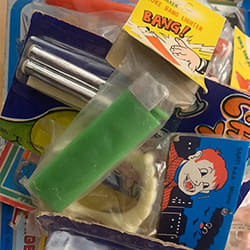
Photo 1
The intention of this exhibition is to turn over works that have fascinating stories about their reverse sides to allow visitors to appreciate them, works that hitherto only collectors and art museum staff had known about. For example, as soon as you enter the building you are greeted by a perfect replica of the reverse side of “Las Meninas” (“The Ladies-in-waiting”) the masterpiece by Velázquez, called the crowning jewel of the Museo del Prado. I guess the bold composition, with about a quarter of the left side of the work being the reverse side of the canvas, is based on wanting to match the intention of the exhibition. Photo 1 shows Velázquez original and the reverse side by Vik Muniz.
In June 2018, the work was taken off the wall for the technical staff to examine it and gain an understanding of its condition. They inspected it in fine detail, photographed it, and from their findings discovered that the present-day wooden frame was made out of pine around 1920 by the Cano family. At the time, the workshop that made the original metal fittings no longer existed, so they used the same materials, which they discovered at a flea market in Madrid after conducting a search. They even went as far as counting the number of flax threads in the canvas, meaning that it was meticulously restored, even down to the penetration of the oil.

Photo 2

Photo 3
Guernica, that large painting by Picasso considered one of his most important works, was exhibited in the Spain Pavilion at the Paris Expo before it toured the world as a symbol of peace and opposition to war. The current exhibition displays the demountable wooden frame that accompanied the painting on that tour. Photo 2 shows parts of the wooden frame used for that touring exhibition at the time, which has been borrowed from the Museo Nacional Centro de Arte Reina Sofía (Queen Sofía National Museum Art Centre).
The reverse side of a painting reveals its history and any changes in ownership, and it is possible to discern various circumstances to do with a painting from stamps and seals, brandings on the back of the base, explanatory notes about the artist, traces of what the poor artist has used to save on canvas costs, and even secret images that the artist would hesitate to make public.
Photo 3 shows a completely mischievous painting by Martin van Meytens, who was the official portraitist of Empress Maria Theresa of Vienna in the 18th century. His employer instinctively disliked expressions of nudity in art, so, perhaps he was being careful by painting a pious nun in prayer on the public-facing side, and her bare backside on the reverse side. The renowned art collector Swedish Ambassador Count Carl Gustaf Tessin hung this copperplate print in the dressing room of his residence while posted to Paris and revealed the back side only to trusted friends. This is exactly what First Secretary of State Manuel Godoy, the owner of Goya’s painting “La Maja Desnuda” (“The Naked Maja”), did.

Photo 4

Photo 5
Photos 4 and 5 show the front and reverse sides of the oldest work in the exhibition, “Funeral de san Antonio Abad” (“The Funeral of Saint Anthony Abbot”), a wooden-panel painting by Fra Angelico from between 1426 and 1430. The “ALB” mark indicates that it was the property of the House of Alba, whose 14th Duke Alba acquired the painting in Florence in 1817.

Photo 6

Photo 7
I noticed metal fittings that appear to be made in Japan on the reverse side of this painting’s frame. They are marked “TAKIYA.” I looked it up and found it is an Osaka hardware manufacturer. They are the work of Takiya Co., Ltd., which makes and sells display fixtures. It is thanks to this “On the Reverse” exhibition that I managed to discover that the latest Japanese technology is providing support for the reverse side of a 6-century-old artwork. Photos 6 and 7 show items custom-made by Takiya for the Prado Museum. I am proud that it is a Japanese company doing work behind the scenes to contribute to displays in famous art galleries and museums around the world including The National Gallery in London, The Louvre Museum in Paris, and The Museum of Modern Art in New York, as well as the Prado Museum (https://takiya.com.e.aiy.hp.transer.com/).
“Reversos” (“On the Reverse”)
Museo Nacional del Prado, Madrid, Spain
November 7, 2023 to March 3, 2024




























































